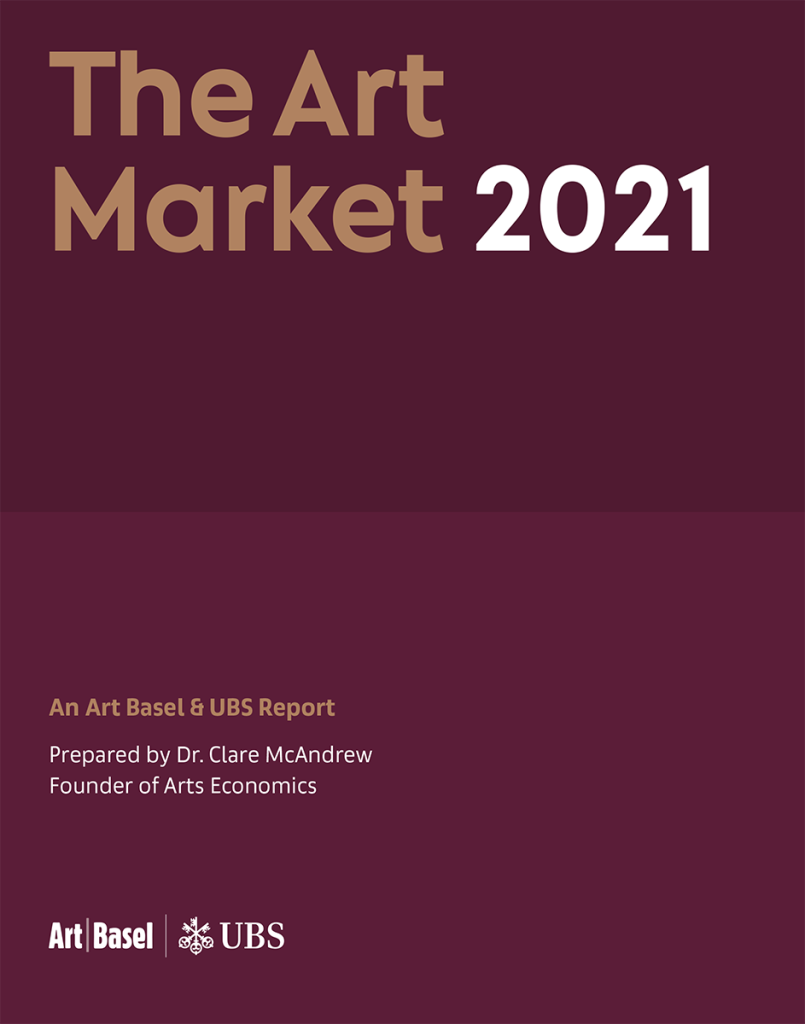The Art Market 2021 Report is out. This Art Basel and UBS survey has been prepared by Dr. Clare McAndrew, Founder of Arts Economics. The Pothi team brings you excerpts and overviews of this incisive report. This is part 2 of a six-part series. Your can read part 1 here
 After breaking Crypto Art records in December, Beeple will became the first digital piece to break all action records by selling for $69.3 million
After breaking Crypto Art records in December, Beeple will became the first digital piece to break all action records by selling for $69.3 million
In 2019 and 2020, one of the biggest changes to the regulatory structure of the global art market was the implementation of the EU’s 5th Anti-Money Laundering Directive (5AMLD), particularly in the UK, as the first of the major international art markets to be formally regulated. The full impact of the Directive is still unfolding, in part because the UK postponed the registration deadline for the art market to June 2021 (from the initial January deadline).
Some have confused delayed registration with delayed application of the new law, however, 5AMLD has, in fact, been in effect since January 2020. Given the delay and the confusion over 5AMLD, it would be premature to assess its full impact, but certain challenges are already apparent. Both the domestic UK art market and its international peers are struggling most with the ‘Know Your Customer’ aspects of the ‘Customer Due Diligence’ (CDD) requirements under 5AMLD. As applied in the UK, art market participants are obliged to lift the veil of anonymity and uncover the identities of the ultimate beneficial owner involved in transactions.
The ‘Know Your Customer’ rules are most challenging for many galleries and dealers as they strike at the core of the selling relationship.
Although still burdensome, other aspects of the new law are relatively less difficult to endure. These include routine compliance obligations such as:
conducting a risk assessment; implementing policies,
procedures, and a training program that addresses
the identified risks; appointing a Money Laundering
Reporting Officer who is adequately supported;
and monitoring the program and keeping relevant records.
 Workers carry “Judith and Holofernes,” believed to be by Caravaggio, to a public presentation at the Drouot auction house in Paris earlier this month. (Francois Guillot / AFP/Getty Images)
Workers carry “Judith and Holofernes,” believed to be by Caravaggio, to a public presentation at the Drouot auction house in Paris earlier this month. (Francois Guillot / AFP/Getty Images)
These obligations are not directly intrusive to the dealer – client relationship, however, they have added burdens in both direct costs and time. In a year when sales in the market were down by more than 20%, some of these costs, such as the £5,000 to set up the anti-money laundering function, have been particularly burdensome, particularly on some smaller businesses. Additional hidden costs include staff training, program administration, and management time, as well as a need potentially for upgraded data systems to better track and retrieve relevant information for government audits.
However, in contrast to these relatively minor issues, the most intrusive and costly in terms of possibly lost, legitimate business are the ‘Know Your Customer’ duties. ‘Knowing’, in the anti-money laundering sense, may be divided into three parts, all of which need to be completed before any payment is accepted by a dealer: does the transaction ‘make sense’ given the deal structure, who the buyer is and their wealth; the need to obtain proof of the ultimate buyer’s identity.
To determine whether a transaction ‘makes sense’, The UK applies a risk-based approach to uncover anything problematic, unusual, or suspicious. Aspects Of a risk-based approach might include whether the person is on any sanctions or terrorist lists, are they politically exposed person (involved with, or a close relative of, a government official), is their source of wealth readily known or easily ascertained, is the amount of their potential purchase consistent with their means, do the locations of their work, residence, and bank make sense and are they located in a high-risk jurisdiction for money laundering, as defined by the EU.
 Price of this piece by Leonardo da Vinci is 150 million dollars
Price of this piece by Leonardo da Vinci is 150 million dollars
Moving to the next steps and assuming a simple sale to a private individual, the dealer must also obtain proof of the individual’s identity that they need to then verify. The proof is often an official, government issued document that is in date and contains a photograph and the date of birth (with the standard being a valid passport or driver’s license). The next CDD step is verification in two parts – ideally seeing the document and the person together to confirm the likeness, and verifying the residential address in the form of a bill dated within the last three months, such as a utility, tax, or phone statement. Some dealers fear that certain serious collectors or particularly well-known individuals and celebrities may be reluctant to show a passport or driver’s license, to say nothing of producing a recent utility bill. Even if they do not mind in principle, securing this information risks diminishing a client’s impulse to purchase. In contrast to the art market, when the same high net worth client buys a £10,000 outfit, they need only produce a credit card and are free to leave the shop with their purchase.
CDD becomes yet more challenging when a buyer has an art advisor and the ultimate client/purchaser I a company of which the buyer is the sole shareholder, known in AML circles as the ultimate beneficial owner or UBO. In this scenario, the art advisor must provide to the seller dealer proof of CDD on themselves and their authority to act as an agent, as well as disclosing the identity of their ultimate client, in this case the sole se shareholder of the corporation. In guidance for the UK art market approved by Her Majesty’s Treasury, the dealer may rely on the agent’s CDD, if the agent themself is regulated. However, in reality, the ultimate client’s identity still needs to be disclosed, even if not immediately, within the supporting identification and verification documents.
The agent must confirm to the dealer the CDD steps they have taken to satisfy themselves about their client, and a generic statement will not do. This disclosure of the ultimate client is problematic for each party – the dealer, the agent, and the client. It is problematic for the dealer as it remains liable for criminal fines and imprisonment if there is a problem with the ultimate client’s CDD. For competitive reasons, the agent has no interest in disclosing the name of their client, and the client may be working with an agent precisely to remain anonymous. This scenario is exponentially more difficult if the agent and the client are in the US or in other regions that are not yet covered by a local anti-money laundering regime.
In this case, the UK dealer may not rely on the US agent’s due diligence but should secure the CDD information for themselves, which presents one of the most problematic scenarios and one not uncommon particularly at the higher end of the sector. This uneven playing field for the many US/UK transactions that occur appears to be a relatively short-term discrepancy, as the US is aggressively enhancing its own efforts to expand money laundering regulations to include the entire US fine art market. The US government is not only actively urging that its domestic art market adopt a risk-based approach to AML compliance, but the Federal Government has already decided to regulate the antiquities market and is conducting a study in 2021 to decide whether e shareholder of the corporation.
In guidance for the UK art market approved by Her Majesty’s Treasury, the dealer may rely on the agent’s CDD, if the agent themself is regulated. However, n reality, the ultimate client’s identity still needs to be disclosed, even if not immediately, within the upporting identification and verification documents The agent must confirm to the dealer the CDD steps they have taken to satisfy themselves about theirclient, and a generic statement will not do his disclosure of the ultimate client is problematic for each party – the dealer, the agent, and the client.
It is problematic for the dealer as it remains liable for criminal fines and imprisonment if there is a problem with the ultimate client’s CDD. For competitive reasons, the agent has no interest in disclosing the name of their client, and the client may be working with an ent precisely to remain anonymous. This scenario is exponentially more difficult if the agent and the client are in the US or in other regions that are not yet covered by a local anti-money laundering regime.
In this case, the UK dealer may not rely on the US agent’s due diligence but should secure the CDD information for themselves, which presents one of the most problematic scenarios and one not uncommon particularly at the higher end of the sector. This uneven playing field for the many US/UK transactions that occur appears to be a relatively short-term discrepancy, as the US is aggressively enhancing its own efforts to expand money laundering regulations to include the entire US fine art market.
The US government is not only actively urging that its domestic art market adopt a risk-based approach to AML compliance, but the Federal Government has already decided to regulate the antiquities market and is conducting a study in 2021.






